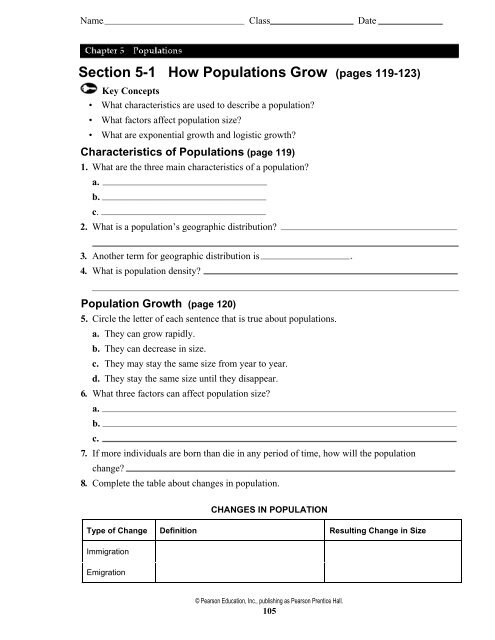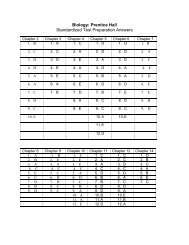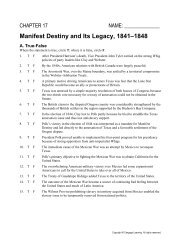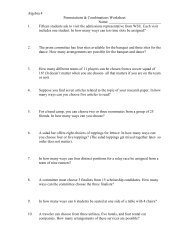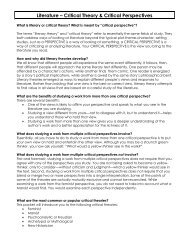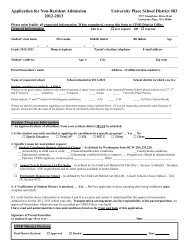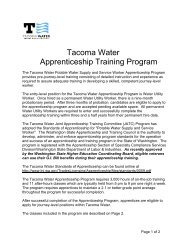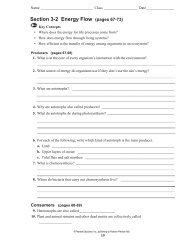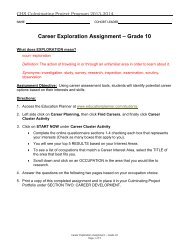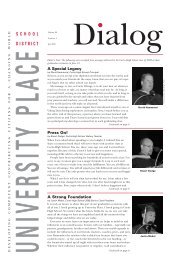Section 5-1 How Populations Grow (pages 119-123)
Section 5-1 How Populations Grow (pages 119-123)
Section 5-1 How Populations Grow (pages 119-123)
You also want an ePaper? Increase the reach of your titles
YUMPU automatically turns print PDFs into web optimized ePapers that Google loves.
Name<br />
Class Date<br />
<strong>Section</strong> 5-1 <strong>How</strong> <strong>Populations</strong> <strong>Grow</strong> (<strong>pages</strong> <strong>119</strong>-<strong>123</strong>)<br />
Key Concepts<br />
• What characteristics are used to describe a population?<br />
• What factors affect population size?<br />
• What are exponential growth and logistic growth?<br />
Characteristics of <strong>Populations</strong> (page <strong>119</strong>)<br />
1. What are the three main characteristics of a population?<br />
a.<br />
b.<br />
c.<br />
2. What is a population’s geographic distribution?<br />
3. Another term for geographic distribution is<br />
4. What is population density?<br />
Population <strong>Grow</strong>th (page 120)<br />
5. Circle the letter of each sentence that is true about populations.<br />
a. They can grow rapidly.<br />
b. They can decrease in size.<br />
c. They may stay the same size from year to year.<br />
d. They stay the same size until they disappear.<br />
6. What three factors can affect population size?<br />
a.<br />
b.<br />
c.<br />
7. If more individuals are born than die in any period of time, how will the population<br />
change?<br />
8. Complete the table about changes in population.<br />
CHANGES IN POPULATION<br />
Type of Change Definition Resulting Change in Size<br />
Immigration<br />
Emigration<br />
© Pearson Education, Inc., publishing as Pearson Prentice Hall.<br />
105
Name<br />
Class Date<br />
9. What are two possible reasons individuals may immigrate into an area?<br />
Exponential <strong>Grow</strong>th (page 121)<br />
10. <strong>How</strong> will a population change if there is abundant space and food and if the population<br />
is protected from predators and disease?<br />
11. When does exponential growth occur?<br />
12. What are three ways that a growth rate may be stated, or expressed?<br />
13. Under ideal conditions with unlimited resources, how will a population grow?<br />
14. Complete the graph by drawing the characteristic shape of exponential population<br />
growth.<br />
Exponential <strong>Grow</strong>th of Bacterial Population<br />
15. Is the following sentence true or false? Elephants never grow exponentially because<br />
their rate of reproduction is so slow.<br />
Logistic <strong>Grow</strong>th (<strong>pages</strong> 122-<strong>123</strong>)<br />
16. Circle each sentence that is true about exponential growth.<br />
a. It continues until the organism covers the planet.<br />
b. It continues at the same rate as resources become less available.<br />
c. It does not continue in natural populations for very long.<br />
d. It continues in natural populations until the birthrate increases.<br />
© Pearson Education, Inc., publishing as Pearson Prentice Hall.<br />
106
Name<br />
Class Date<br />
17. When resources become less available, how does population growth change?<br />
18. When does logistic growth occur?<br />
19. Circle the letter of each instance when a population’s growth will slow down.<br />
a. The birthrate and death rate are the same.<br />
b. The birthrate is greater than the death rate.<br />
c. The rate of immigration is equal to the rate of emigration.<br />
d. The rate of emigration is less than the rate of immigration.<br />
20. What is the carrying capacity of the environment for a particular species?<br />
21. Complete the graph by drawing the characteristic shape of logistic population growth.<br />
Logistic <strong>Grow</strong>th of a Population<br />
© Pearson Education, Inc., publishing as Pearson Prentice Hall.<br />
107


